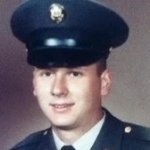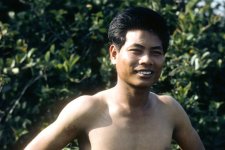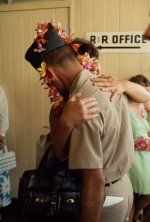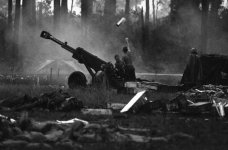jazzeum
Four Star General
- Joined
- Apr 23, 2005
- Messages
- 38,888
A Mistake Has Been Made by Jim Larsen, a retired community newspaper editor.

Joe Paul Larsen
My brother, Joe Paul Larsen, worked the summer of 1966 for the Washington State highway department as a road worker. He was the good son. Dependable, hard working, likable, devoted steelhead fisherman, duck hunter, dairy farm worker and a Future Farmers of America kid who raised blue-ribbon winning black angus cattle at the Evergreen State Fair in Monroe. He only had two angus, but he regularly beat the big Snohomish River Valley ranchers who raised scores or even hundreds of angus. He backpacked baby fish into high mountain lakes, hiking the high trails with snowshoes.
His road job ended that fall, and he prepared for year two at Everett Junior College. He got a part-time job as a janitor at General Telephone and signed up for 12 class hours, the minimum required to avoid the draft. It made our parents happy. Our dad had carried a mortar through North Africa, Italy, Germany and Austria, and was no fan of war.
Classes soon started and before long Joe received a draft notice. Neither he nor our father could believe it. A mistake? Yes, a mistake had been made. Joe had signed up for a five-credit math class, three-credit English class and five-credit biology class. Or so the latter was listed in the course catalog. In fact, the two-hour lab portion of the biology class did not count, so he only had 11 hours. A college cleric made the error, or perhaps a typesetter hurrying to meet a deadline. Whatever, he got drafted. The draft board in Everett was hard nosed. A rule was a rule.
Joe entered the Army in October. He earned a sharpshooting medal, came home for Christmas and after more training soon departed for Vietnam.
He liked the Army and felt the United States was doing the right thing, because of how the peasants in Vietnam were being slaughtered by the Communists. One day near the Cambodian border his platoon came under heavy fire. Twenty-two, including Joe, were killed. The sergeant leading them that day was among the dead. He was awarded the Medal of Honor.
My family got the news early Sunday morning. The green car moved slowly up the long driveway toward the house. Two car doors were opened. A knock on the door. Mom screamed, so did my sister. Dad ran up the stairs to where his other son was still in bed. A junior college dropout, I’d worked the night before at the plywood mill. It was May 18, just over a month away from my 19th birthday and the inevitable draft notice.
Dad sat on the bed, which he never did, and grabbed my shoulder. "They're not getting you," he said.
Dad took Monday off from the mill. We drove silently to the draft board, located under a tavern on Hewitt Avenue in Everett. "You took my oldest son, you can't have this one," he told the desk clerk. Embarrassed, I watched from a distance. Dad didn't get the answer he wanted and was directed to a door. He entered and after a few minutes, came out. "Let's go," he said.
I never found out what happened. A draft notice never came. When the lottery began, I didn't get a lottery number. Eventually I researched the draft regulations. There didn't seem to be an exemption for a surviving son. Whoever Dad talked to that day must have simply erased his younger son's name from the draft rolls. Improper, no doubt.
Joe would have been a forest ranger, or something similar. Smart and well liked, he would have led a department. He would have had a large, loving family, living perhaps in an expansive log home in the area around Index, a small town in Snohomish County, which he loved. The hole left in the family never healed.
I took 10-years to get a four-year degree and ended up spending several decades in the community newspaper business. I always felt like a coward for not enlisting.
His road job ended that fall, and he prepared for year two at Everett Junior College. He got a part-time job as a janitor at General Telephone and signed up for 12 class hours, the minimum required to avoid the draft. It made our parents happy. Our dad had carried a mortar through North Africa, Italy, Germany and Austria, and was no fan of war.
Classes soon started and before long Joe received a draft notice. Neither he nor our father could believe it. A mistake? Yes, a mistake had been made. Joe had signed up for a five-credit math class, three-credit English class and five-credit biology class. Or so the latter was listed in the course catalog. In fact, the two-hour lab portion of the biology class did not count, so he only had 11 hours. A college cleric made the error, or perhaps a typesetter hurrying to meet a deadline. Whatever, he got drafted. The draft board in Everett was hard nosed. A rule was a rule.
Joe entered the Army in October. He earned a sharpshooting medal, came home for Christmas and after more training soon departed for Vietnam.
He liked the Army and felt the United States was doing the right thing, because of how the peasants in Vietnam were being slaughtered by the Communists. One day near the Cambodian border his platoon came under heavy fire. Twenty-two, including Joe, were killed. The sergeant leading them that day was among the dead. He was awarded the Medal of Honor.
My family got the news early Sunday morning. The green car moved slowly up the long driveway toward the house. Two car doors were opened. A knock on the door. Mom screamed, so did my sister. Dad ran up the stairs to where his other son was still in bed. A junior college dropout, I’d worked the night before at the plywood mill. It was May 18, just over a month away from my 19th birthday and the inevitable draft notice.
Dad sat on the bed, which he never did, and grabbed my shoulder. "They're not getting you," he said.
Dad took Monday off from the mill. We drove silently to the draft board, located under a tavern on Hewitt Avenue in Everett. "You took my oldest son, you can't have this one," he told the desk clerk. Embarrassed, I watched from a distance. Dad didn't get the answer he wanted and was directed to a door. He entered and after a few minutes, came out. "Let's go," he said.
I never found out what happened. A draft notice never came. When the lottery began, I didn't get a lottery number. Eventually I researched the draft regulations. There didn't seem to be an exemption for a surviving son. Whoever Dad talked to that day must have simply erased his younger son's name from the draft rolls. Improper, no doubt.
Joe would have been a forest ranger, or something similar. Smart and well liked, he would have led a department. He would have had a large, loving family, living perhaps in an expansive log home in the area around Index, a small town in Snohomish County, which he loved. The hole left in the family never healed.
I took 10-years to get a four-year degree and ended up spending several decades in the community newspaper business. I always felt like a coward for not enlisting.

Joe Paul Larsen





